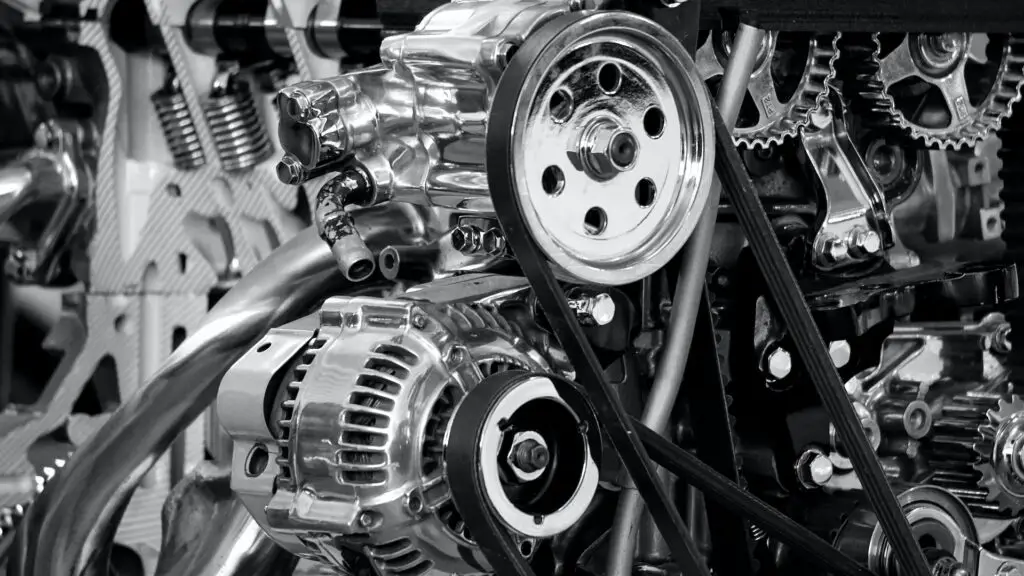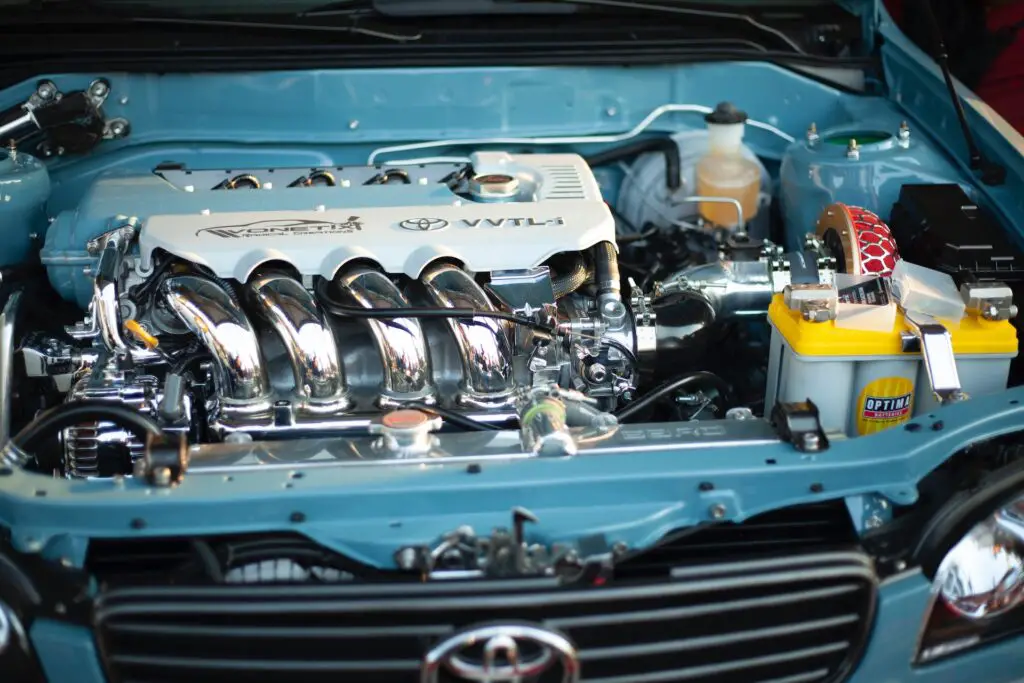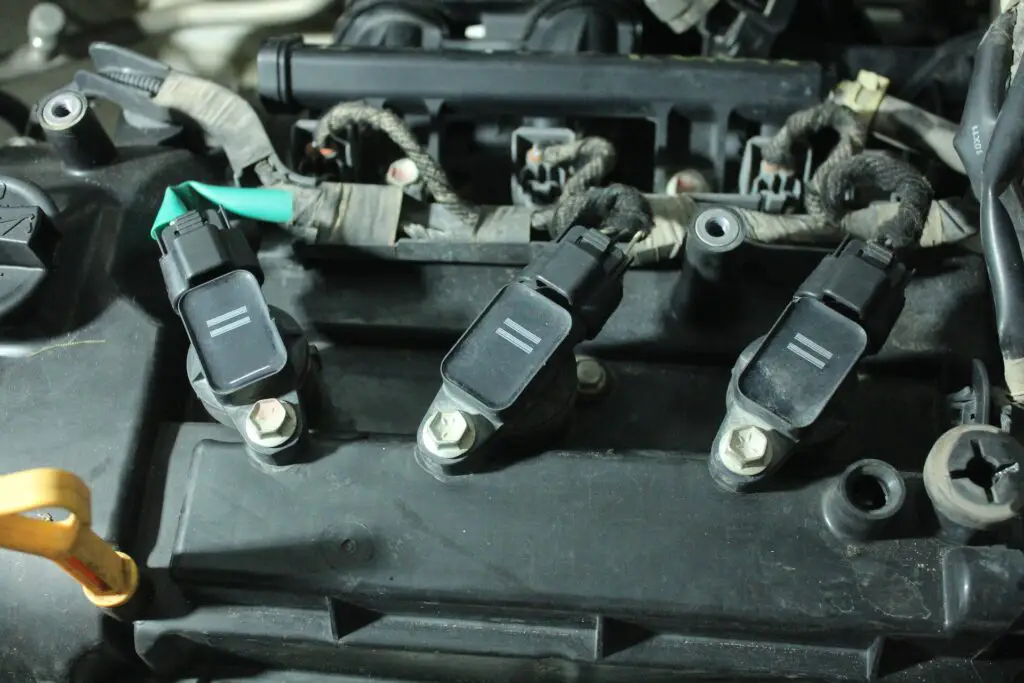When a car owner or enthusiast contemplates a timing chain replacement cost, the thought unveils a landscape. This is where engineering intricacies intersect with economic realities. By trying to navigate the decision-making process surrounding this essential maintenance procedure.
The need for a timing chain replacement marks a significant juncture in the lifecycle of an engine. A moment when mechanical prowess collides with financial considerations.
In the heart of every internal combustion engine, an intricate ballet of components unfolds. They are meticulously choreographed to produce power, efficiency, and the unmistakable hum of motion.
Among these components, the timing chain stands as a stalwart conductor. It orchestrates the harmonious rhythm between the engine’s valves and pistons.
This unassuming yet vital component ensures that the engine’s internal symphony plays out in perfect synchrony. This then propels us forward with each turn of the ignition key.
However, just like any meticulously choreographed performance, the timing chain’s lifespan is not infinite. Over time and extended use, the once-precise interplay between its links can falter. This can lead to potentially catastrophic consequences for the engine’s overall health.
As the timing chain stretches, wears, or even breaks, the once-precise synchronization between valves and pistons falters. This risks collision and subsequent damage within the engine’s intricate architecture.
In this article, we will embark on a journey through the intricacies of timing chains. We will delve into the reasons behind their replacement, and the mechanical choreography that unfolds during the procedure. Additionally, we will discuss the factors that shape the timing chain replacement cost.
By delving into this multifaceted topic, we aim to equip vehicle owners and enthusiasts alike with the knowledge needed to navigate the complexities of timing chain replacement costs.
Table of Contents
What Is a Timing Chain?
A timing chain is a crucial component within an internal combustion engine that synchronizes the movement of the engine’s pistons and valves, ensuring precise and harmonious operation.
Comprised of interlocking metal links, similar to a bicycle chain but far more robust, the timing chain is located within the engine and connects the crankshaft.
This converts the engine’s linear motion into rotational power, to the camshaft, responsible for controlling the opening and closing of the engine’s intake and exhaust valves.
As the crankshaft rotates, the timing chain transfers this rotational motion to the camshaft, dictating the timing and duration of valve openings and closings in relation to the piston positions.
This synchronization is essential to prevent collision between the valves and pistons, ensuring optimal engine performance and efficiency.
Unlike timing belts, which are made of rubber and require regular replacement, timing chains are generally more durable due to their metal construction.
However, they too can eventually wear over time, necessitating replacement to maintain the engine’s precise timing and functionality.
What Does the Timing Chain Do?
The timing chain plays a pivotal role in the orchestration of an internal combustion engine’s intricate mechanical symphony.
Situated within the engine, the timing chain synchronizes the movement of the crankshaft and the camshaft, two fundamental components that dictate the engine’s overall performance.
As the crankshaft converts the up-and-down motion of the engine’s pistons into rotational power, the timing chain transfers this rotational energy to the camshaft.
This transmission of energy is meticulously timed to ensure that the camshaft opens and closes the engine’s intake and exhaust valves precisely in conjunction with the pistons’ positions.
This orchestrated choreography determines when fuel and air enter the combustion chamber and when exhaust gases exit, influencing critical factors such as fuel efficiency, power output, and emissions.
By preventing collision between the pistons and valves, the timing chain safeguards the engine from potentially catastrophic damage, ensuring the harmonious function of all components involved.
In essence, the timing chain is the conductor of this mechanical ensemble, orchestrating the symphony of combustion with the precision required for optimal engine performance.
How Does the Timing Chain Work?
The operation of a timing chain involves a meticulous dance between the engine’s core components. As the engine’s crankshaft rotates due to the up-and-down motion of the pistons, the timing chain, linked to the crankshaft, begins to move in tandem.
This rotational motion is then transmitted to the camshaft, situated above the cylinder head, which controls the opening and closing of the intake and exhaust valves.
The timing chain’s intricate interlocking links ensure that this rotational energy is accurately transferred, dictating the timing and duration of valve movements.
In a four-stroke engine cycle, as the piston descends during the intake stroke, the intake valve opens, permitting a precise mixture of air and fuel to enter the combustion chamber. Simultaneously, the exhaust valve remains closed.
When the piston ascends during the intake stroke, both valves are shut, sealing the combustion chamber. As the spark plug ignites the fuel mixture, the piston is driven down during the power stroke.
Finally, the exhaust valve opens, and the rising piston expels the burnt gases during the exhaust stroke.
The timing chain ensures that these valve movements correspond impeccably with the piston’s position, creating a seamless synergy between these components and facilitating the engine’s overall performance.
Why Does a Timing Chain Break?
A timing chain is a durable component designed to withstand the rigors of an engine’s operation. However, it can eventually fail due to various factors.
One common reason is wear and stretching over time. As the engine runs, the constant movement and tension placed on the timing chain can cause it to gradually elongate.
This can throw off the precise synchronization between the crankshaft and the camshaft, leading to poor engine performance, misfires, and potential damage.
Additionally, inadequate lubrication can contribute to timing chain failure. The timing chain relies on proper lubrication to reduce friction and wear.
If the engine’s oil is not changed regularly or is of poor quality, it can lead to increased friction and accelerated wear on the timing chain and its associated components.
Another factor that can cause timing chain failure is debris or foreign objects entering the engine. If particles find their way into the engine oil, they can cause abrasive damage to the timing chain and its guides, leading to premature wear and potential breakage.
High engine temperatures can also play a role in timing chain failure. Overheating can cause the metal components of the timing chain to weaken and lose their structural integrity, making them more susceptible to breaking under stress.
Lastly, manufacturing defects or poor-quality materials can also contribute to timing chain failure. If the timing chain is not made to the required specifications or if it is subjected to poor quality control during manufacturing, it may be more prone to breaking prematurely.
Timing chains can break due to wear and stretching over time, inadequate lubrication, debris in the engine, high engine temperatures, and manufacturing defects.
Regular maintenance, including oil changes and inspections, can help mitigate some of these risks and prolong the life of the timing chain.
What are the Symptoms of a Bad Timing Chain?
A failing timing chain can exhibit a range of symptoms, often indicating that there’s an issue with the precise synchronization of the engine’s components.
Recognizing these symptoms early can help prevent further damage and avoid potential engine failure. Below are some of the common signs of a bad timing chain:

1. Engine Misfires and Rough Running
When the timing chain is worn or stretched, the precise synchronization between the pistons and valves can be disrupted. This can lead to misfires, where the air-fuel mixture isn’t ignited correctly, resulting in a lack of power and rough engine operation.
For instance, you might feel your car shuddering or vibrating while accelerating, or it might hesitate when you try to pick up speed as if it’s struggling to deliver the expected power output.
2. Unusual Engine Noise
A distinct rattling or ticking noise often likened to marbles rattling around inside the engine, can indicate a loose or damaged timing chain. This noise is particularly noticeable when the engine is idling or running at lower speeds.
Imagine the sound of a handful of pebbles being shaken in a tin can, and you’ll get an idea of how this irregular noise might manifest.
3. Check Engine Light (CEL) Illumination
A malfunctioning timing chain can trigger the Check Engine Light on your dashboard. This light is an indicator that something isn’t functioning optimally within your engine system. When this light comes on, it’s crucial to have your vehicle’s diagnostics scanned to retrieve specific trouble codes.
For instance, a trouble code such as P0016 or P0017 often points to a problem with camshaft/crankshaft correlation, indicating a possible timing chain issue.
4. Poor Fuel Efficiency
Disrupted timing can lead to inefficient combustion, where the air-fuel mixture isn’t ignited optimally. As a result, the engine has to work harder to produce power, leading to decreased fuel efficiency.
You might notice that you’re visiting the gas station more frequently, even if your driving habits haven’t changed significantly.
5. Difficulty Starting
When the timing chain isn’t working correctly, the engine’s timing might be off enough to make starting the car a challenge.
It could take longer cranking times, and in extreme cases, the engine might not start at all. You could find yourself repeatedly turning the key or pressing the start button without success.
6. Engine Stalling
A severely worn timing chain can disrupt the timing between the pistons and valves to the point where the engine might stall suddenly while driving, especially during deceleration or at idle.
This abrupt stall can catch you off guard and potentially pose safety risks, especially if it happens in traffic.
7. Loss of Power and Acceleration
With a compromised timing chain, the engine’s power output and acceleration performance can suffer. You might notice that your vehicle struggles to accelerate smoothly, especially when merging onto highways or overtaking slower vehicles.
8. Backfiring
Poor timing can cause unburned fuel to enter the exhaust system. When this fuel ignites in the exhaust, it can lead to backfiring – a loud popping sound. This can be startling and might also be accompanied by visible flames from the exhaust.
9. Engine Overheating
Incorrect exhaust valve timing due to timing chain issues can affect the cooling system’s efficiency. Insufficient evacuation of exhaust gases can lead to increased engine temperatures.
If your engine temperature gauge climbs into the red zone frequently, it could be due to timing chain-related issues affecting the cooling process.
NOTE: Recognizing these symptoms and addressing them promptly through proper diagnosis and timing chain replacement, if necessary, can prevent more extensive engine damage and ensure the continued smooth operation of your vehicle.
How Much Does a Timing Chain Replacement Cost?
The timing chain replacement cost can vary widely depending on several factors. The make and model of your vehicle play a significant role, with luxury and high-performance cars potentially having more complex timing chain systems, resulting in higher costs.
Labor charges are a substantial component, influenced by the location and expertise of the repair shop. Additionally, the specific parts used, whether OEM or aftermarket, can impact the cost.
The timing chain replacement might also involve changing related components like tensioners, guides, and sprockets, which adds to the overall expense.
Other considerations include whether the repair shop offers warranties or guarantees, as well as any additional repairs or maintenance tasks identified during the replacement process.
On average, timing chain replacement costs can range from $600 to $1,800 or more, but for accurate pricing, it’s advisable to obtain estimates from local repair shops or dealerships based on your vehicle’s specifics and your location.

How Much Is Professional Timing Chain Replacement Cost?
A professional timing chain replacement cost is influenced by several key factors that collectively determine the overall expense.
Labor charges constitute a significant portion of the cost, as the process involves skilled mechanics disassembling parts of the engine to access and replace the timing chain.
The complexity of the engine design, accessibility, and expertise of the repair shop can all impact labor rates.
Additionally, the choice of parts plays a role, with OEM (Original Equipment Manufacturer) parts typically being more expensive but often considered of higher quality and better fit.
The replacement might also involve related components like tensioners, guides, and sprockets, adding to the cost.
Depending on the vehicle’s make and model, location, and the aforementioned factors, the professional timing chain replacement cost can range from around $600 to $1,800 or even higher.
However, for precise estimates tailored to your vehicle and location, it’s recommended to consult local repair shops or dealerships, ensuring transparency in pricing and a thorough understanding of the services included.
Can I Replace the Timing Chain Myself to Save on the Timing Chain Replacement Cost?
While it’s technically possible to replace the timing chain yourself to save on the timing chain replacement cost, it’s a complex and precision-critical task that requires advanced mechanical skills, specialized tools, and a deep understanding of your vehicle’s engine.
Timing chain replacement involves disassembling a significant portion of the engine, ensuring precise alignment and tension, and correctly timing the camshaft and crankshaft.
A small error during the process can lead to severe engine damage or poor performance. If you’re an experienced DIY mechanic and have successfully tackled similar engine projects, you might consider it.
However, for most people, this task is best left to professional mechanics who have the necessary expertise and tools to ensure a proper and safe replacement.
Mistakes during the DIY process can result in even higher repair costs or, in extreme cases, engine replacement. It’s essential to weigh the potential risks against the cost savings and consider your skills and comfort level before attempting a timing chain replacement on your own.
How Much Is DIY Timing Chain Replacement Cost?
A DIY timing chain replacement cost can be significantly lower than having it done professionally, but it’s essential to consider the expenses involved in a detailed manner.
The primary costs include the replacement timing chain kit, which typically includes the timing chain, guides, tensioners, and possibly other related components.
These kits can range from $70 to $250 or more, depending on your vehicle’s make and model. Additionally, you might need to invest in specialized tools required for the job, such as a torque wrench, socket set, and potentially an engine timing tool kit.
These tools can add another $70 to $150 or more to your expenses. While the upfront cost might seem lower, it’s crucial to factor in the value of your time, the learning curve, and the potential risks of making mistakes during a complex engine procedure.
A DIY timing chain replacement requires a high level of mechanical skill, attention to detail, and a thorough understanding of your vehicle’s engine.
If done incorrectly, it can lead to costly engine damage, necessitating professional repairs or even a full engine replacement. It’s essential to evaluate your skill level, available tools, and potential risks before deciding on a DIY timing chain replacement.
What Factors Influence the Timing Chain Replacement Cost?
The timing chain replacement cost can be influenced by several factors, each of which plays a role in determining the overall expense. Let’s examine each of these factors in detail:
1. Vehicle Make and Model
Different vehicles have varying engine designs, complexities, and accessibility. For instance, replacing the timing chain in a compact economy car might be less labor-intensive than doing so in a luxury sedan with a more intricate engine layout.
2. Labor Costs
The labor charges constitute a significant portion of the cost. Labor rates can vary based on the repair shop’s location, reputation, and expertise. For example, a reputable shop in a metropolitan area might charge higher hourly rates compared to a smaller town.
3. Parts Cost
The primary cost involves the replacement timing chain kit, which includes the chain itself, guides, tensioners, and potentially other components. OEM parts tend to be more expensive but are often considered more reliable.
Aftermarket parts might be more affordable but could vary in quality. A high-performance sports car might have pricier timing chain components compared to a basic sedan.
4. Additional Component Replacement
During the timing chain replacement, other related components like tensioners, guides, and sprockets might also need replacement. Opting to replace these components as part of the repair can add to the overall cost.
5. Location
The cost of living and the local economy can impact labor rates. For instance, repair shops in regions with higher living costs might charge more for their services.

6. Repair Shop Type
Dealerships might have higher labor rates compared to independent mechanics. However, dealerships often use OEM parts, which can contribute to a higher overall cost.
7. Additional Repairs or Maintenance
Sometimes, the timing chain replacement process might uncover other issues that require attention. Addressing these problems during the same repair can increase the total cost. For example, fixing an oil leak or replacing a water pump can add expenses.
8. Warranty and Guarantees
Some repair shops offer warranties on both parts and labor. While this might slightly increase the upfront cost, it can provide peace of mind regarding the quality of the work performed.
9. DIY vs. Professional Repair
If you’re doing the replacement yourself, you’ll need to factor in the cost of specialized tools required for the job.
Additionally, your time and expertise are valuable resources to consider. Mistakes made during a DIY repair could lead to higher costs in the long run.
NOTE: By understanding these factors and their impacts, you can make informed decisions about timing chain replacement, considering both your vehicle’s specific needs and your budget constraints.
What Does Timing Chain Replacement Entail?
Timing chain replacement is a comprehensive procedure that involves disassembling and reassembling a significant portion of the engine to ensure the proper functioning of the timing chain system.
The process typically includes removing various components such as the engine cover, intake manifold, and possibly the front engine accessories (belts, pulleys, etc.).
Once access is gained to the timing chain, it’s essential to accurately mark the current position of the camshaft and crankshaft to ensure proper alignment during reassembly.
The old timing chain, along with associated components like guides and tensioners, is removed. The new timing chain is then carefully installed, paying close attention to the correct alignment of timing marks.
This process might also involve replacing additional components if they show signs of wear. Finally, after reassembly, the engine’s timing is adjusted, and the system is thoroughly tested to ensure proper synchronization and performance.
It’s a meticulous task that requires precision, specialized tools, and a deep understanding of engine mechanics to prevent potential damage and ensure the engine runs smoothly and efficiently.
What Other Parts Do I Need to Replace When Replacing the Timing Chain?
When replacing the timing chain, it’s often recommended to replace certain related components to ensure optimal performance and longevity. These components may include:
1. Timing Chain Guides and Tensioners
These components help maintain proper tension and alignment of the timing chain. Over time, they can wear or become brittle, leading to improper chain tension and potential misalignment.
For example, if you’re replacing the timing chain in a BMW N54 engine, you would likely replace the chain guides, tensioners, and other related components like the chain sprockets.
2. Crankshaft and Camshaft Seals
Since you’ll already have the engine partially disassembled, it’s a good idea to replace these seals, which can prevent oil leaks in the future.
For instance, when replacing the timing chain in a Honda K-series engine, replacing the crankshaft and camshaft seals is often advised.
3. Water Pump
If your vehicle’s water pump is driven by the timing chain, it’s prudent to replace it while the timing chain is being replaced. This prevents future disassembly and potential additional costs. For example, many Mini Cooper models have the water pump connected to the timing chain system.
4. Front Engine Seals and Gaskets
These seals and gaskets are located near the timing chain area and can deteriorate over time, leading to oil leaks.
Replacing them during the timing chain replacement prevents the need for a separate repair in the near future. Some Audi and Volkswagen models are known for needing front engine seals and gasket replacement during timing chain work.
5. Sprockets and Pulleys
If these components are showing signs of wear or damage, it’s wise to replace them as well. Damaged sprockets or pulleys can cause improper chain alignment and tension. Vehicles with variable valve timing might have additional sprockets that require replacement.
6. Variable Valve Timing Components
For engines equipped with variable valve timing (VVT) systems, components like solenoids and oil control valves might need replacement if they’re faulty or contribute to timing issues. BMW’s VANOS system is an example of VVT that might require attention during timing chain work.
7. Drive Belts
Since you’ll likely need to remove drive belts to access the timing chain, inspecting and potentially replacing these belts can be a practical step, especially if they’re worn.
NOTE: Remember that the need for these additional replacements can vary based on your vehicle’s make, model, and mileage. Consulting your vehicle’s service manual and seeking advice from knowledgeable professionals can help you determine which additional parts are necessary for your specific situation.
Timing Chain Replacement – A Step-by-Step Procedure
Replacing a timing chain is a complex procedure that requires precision and attention to detail. Here’s a step-by-step overview of the process:
Note: This is a generalized guide.
Your specific vehicle’s service manual should always be consulted for accurate instructions. If you’re not experienced with engine work, it’s recommended to have a professional mechanic perform this procedure.
1. Gather Necessary Tools and Parts
Collect the required tools such as socket sets, torque wrenches, timing tool kits (if needed), and safety gear. Ensure you have the replacement timing chain kit, which includes the timing chain, guides, tensioners, and related components.
2. Disconnect Battery
Disconnect the vehicle’s battery to ensure safety during the procedure.
3. Drain Coolant and Engine Oil
If necessary, drain the coolant and engine oil to prevent spills and contamination.
4. Remove Engine Covers and Components
Remove any necessary components obstructing access to the timing chain. These include the intake manifold, radiator hoses, and front accessories like belts and pulleys.
5. Set Engine to Top Dead Center (TDC)
Rotate the crankshaft to set the engine at the top dead center (TDC) on the compression stroke for cylinder #1. Use timing marks on the crankshaft pulley and engine block as a reference.
6. Mark Timing Alignment
Mark the alignment of the camshaft and crankshaft with their respective timing marks to ensure proper positioning during reassembly.
7. Remove the Timing Chain Cover
Remove the timing chain cover to expose the timing chain and related components.
8. Release Tension and Remove Timing Chain
Release tension from the chain tensioner(s), remove the chain guides, and carefully remove the old timing chain.
9. Inspect and Clean
Inspect the chain guides, tensioners, and sprockets for wear, cracks, or damage. Clean the surrounding area to ensure proper component seating.
10. Install New Timing Chain
Carefully thread the new timing chain through the engine, ensuring alignment with the timing marks on the camshaft and crankshaft.
11. Install Guides and Tensioners
Install the new guides and tensioners as specified in your vehicle’s service manual. Make sure they’re properly aligned and seated.
12. Tension the Chain
Gradually tension the chain, following the manufacturer’s guidelines, to ensure proper alignment and tension throughout the system.
13. Reassemble Components
Reassemble the timing chain cover, front accessories, intake manifold, and any other components that were removed.
14. Set Timing
Using timing tools or the manufacturer’s specified method, set the timing to match the TDC and alignment marks on the crankshaft and camshaft.
15. Reconnect Battery
Reconnect the battery and check for any error codes or warning lights. Clear any codes if necessary.
16. Refill Coolant and Engine Oil
Refill the engine with fresh coolant and engine oil as needed.
17. Test and Inspect
Start the engine and monitor its operation. Listen for unusual noises and check for leaks. Observe the engine’s performance and ensure the timing is accurate.
18. Complete Reassembly
If the engine is running smoothly and there are no issues, complete the reassembly by securing all components, covers, and accessories.
NOTE: It’s important to follow the service manual for your specific vehicle, as the steps and specifications can vary greatly. A timing chain replacement is a complex task. If you’re not experienced with engine work, it’s advisable to seek professional help. This ensures the job is done correctly and safely.
How Can I Keep the Timing Chain Last Longer?
Below is the recommended approach to help extend the lifespan of your timing chain:
- Regular Oil Changes: Timely oil changes with the manufacturer-recommended oil type and viscosity are crucial. Clean and adequate oil reduces friction, lubricates moving parts, and prevents premature wear on the timing chain.
- Quality Oil and Filters: Always use high-quality oil and filters to ensure proper lubrication and filtration of contaminants that can accelerate chain wear.
- Follow Service Intervals: Adhere to your vehicle’s recommended service intervals. Regular check-ups by a qualified mechanic can catch potential timing chain issues early.
- Avoid Overloading and High RPMs: Excessive load and high engine RPMs can strain the timing chain. Drive smoothly and avoid unnecessary stress on the engine.
- Cooling System Maintenance: A well-maintained cooling system prevents excessive heat, which can degrade the timing chain’s integrity. Regularly flush and replace coolant.
- Use High-Octane Fuel: If your engine recommends higher-octane fuel, using it can prevent knocking and misfires that stress the timing chain.
- Listen for Unusual Noises: If you notice unusual rattling or ticking noises from the engine, get it inspected promptly, as it might indicate timing chain issues.
- Avoid Abrupt Starts and Stops: Gradual acceleration and deceleration are easier on the engine components, including the timing chain.
- Monitor Check Engine Light: If the Check Engine Light illuminates, get the vehicle scanned for trouble codes related to the timing system to catch problems early.
- Address Leaks Promptly: Oil leaks near the timing chain area can lead to contamination and premature wear. Fix any leaks promptly.
- Keep Your Vehicle Clean: Regularly cleaning your engine bay helps prevent dirt and debris from accumulating on the timing chain and related components.
- Use the Right Timing Chain Kit: If replacement becomes necessary, opt for high-quality OEM or reputable aftermarket timing chain kits to ensure durability.
FAQs
How Often Should I Replace the Timing Chain?
Unlike timing belts, which have specific replacement intervals, timing chains are designed to last significantly longer. Many modern vehicles are equipped with timing chains that can last the lifetime of the engine if proper maintenance and driving habits are maintained.
However, this doesn’t mean they are immune to wear. The need for timing chain replacement can be influenced by factors such as the vehicle’s make and model, driving conditions, maintenance history, and the quality of engine oil used.
As a general guideline, it’s recommended to inspect the timing chain and related components during major engine overhauls. Additionally, if you notice symptoms of chain wear, like unusual engine noises or poor performance.
Regular oil changes with high-quality oil can also help prolong the timing chain’s lifespan. Consulting your vehicle’s service manual and seeking advice from experienced mechanics can provide insights into when a replacement might be necessary based on your specific circumstances.
What happens If I Don’t Replace the Timing Chain?
If you neglect to replace a worn or damaged timing chain, serious consequences can unfold, leading to extensive engine damage and potential failure.
The timing chain’s role in synchronizing the engine’s components is crucial. If it fails, the pistons and valves can collide. This can result in a phenomenon known as “timing chain skip” or “jump.”
This collision can lead to bent valves, damaged pistons, and even holes in the engine block. Repairing this level of damage is not only costly but might render the engine irreparable.
Furthermore, if the timing chain breaks completely while the engine is running, it can cause a catastrophic failure. This may necessitate a complete engine replacement.
Additionally, a failing timing chain can impact the engine’s overall performance. This can cause misfires, rough idling, reduced power, poor fuel efficiency, and emissions issues.
Given the potential for severe damage and costly repairs, it’s crucial to address timing chain issues promptly. You have to replace the timing chain when it shows signs of wear or damage.
How Long Does a Timing Chain Replacement Take?
The duration of a timing chain replacement can vary significantly based on several factors. The complexity of the engine design, accessibility to the timing chain, the make and model of the vehicle, the mechanic’s expertise, and whether any unforeseen complications arise during the process all influence the time required.
Generally, a straightforward timing chain replacement can take around 4 to 8 hours of labor. However, for more complex engines or vehicles with intricate timing chain systems, the process can extend to 10 hours or more.
Additional time might be needed if related components like guides, tensioners, or sprockets require replacement. It’s important to note that while a timing chain replacement might seem like a time-consuming procedure, it’s crucial not to rush it.
Precision is essential to ensure proper synchronization and performance of the engine. Always consult your mechanic for a more accurate time estimate based on your specific vehicle and circumstances.
Can I Drive with a Bad Timing Chain?
Driving with a bad timing chain is highly discouraged and can lead to severe engine damage.
The timing chain’s role in synchronizing the engine’s components is crucial for proper operation. If the timing chain is worn, stretched, or malfunctioning, it can cause the engine’s timing to become imbalanced.
This can lead to misalignment between the pistons and valves, potentially resulting in valve interference with the pistons.
This collision can cause bent valves, damaged pistons, and even holes in the engine block, leading to costly repairs or engine replacement. Additionally, a failing timing chain can cause poor engine performance, misfires, rough idling, reduced power, and decreased fuel efficiency.
If you suspect a bad timing chain, it’s recommended to avoid driving the vehicle and has it inspected by a professional mechanic as soon as possible to prevent further damage and ensure the safety and reliability of your vehicle.
Is a Timing Chain Covered by Warranty?
Whether a timing chain is covered by a warranty depends on several factors, including the type of warranty, the vehicle’s age, mileage, and the specific terms and conditions outlined in the warranty documentation.
New vehicles often come with a manufacturer’s warranty that covers certain components for a specific period or mileage, usually around 3 years or 36,000 miles.
However, many manufacturer warranties exclude normal wear and tear items like belts and chains, which could include the timing chain.
Some extended warranties might cover timing chain replacement, but it’s essential to carefully review the warranty contract to understand the coverage details.
Additionally, certified pre-owned (CPO) vehicles might come with extended warranties covering certain components, but the specifics can vary.
It’s advisable to consult your vehicle’s warranty documentation and speak with the dealership or warranty provider to determine if timing chain replacement is covered under your specific warranty agreement.
Is a Timing Chain the Same as a Timing Belt?
A timing chain and a timing belt serve similar purposes but are different components with distinct characteristics. Both are vital for synchronizing the engine’s internal components to ensure proper combustion and overall operation.
However, the key differences lie in their composition, durability, and maintenance requirements. A timing chain is typically made of metal and resembles a bicycle chain.
It’s located within the engine and is lubricated by the engine oil, making it more durable and less likely to break.
Timing chains are commonly found in vehicles with heavier engines and are designed to last the lifetime of the engine with proper maintenance. On the other hand, a timing belt is usually made of rubber reinforced with fiber or other materials.
It requires regular replacement, typically between 60,000 to 100,000 miles, as it can wear, crack, or break over time. Timing belts are quieter but less durable than chains and are often found in smaller and lighter engines.
It’s essential to understand which system your vehicle uses and adhere to the recommended maintenance intervals. This will ensure optimal engine performance and longevity.
Is It Worth Fixing a Timing Chain?
Deciding whether it’s worth fixing a timing chain depends on several factors. These include the overall condition of your vehicle, its value, the cost of repair, and your circumstances.
Timing chain replacement can be a significant investment, especially if additional components need replacement or if labor costs are high.
If your vehicle is relatively new, has low mileage, and is in good overall condition, fixing the timing chain might be a reasonable investment to ensure its continued reliability and performance.
On the other hand, if your vehicle is older, has high mileage, and is showing signs of other significant issues, you might need to weigh the repair cost against the potential value of the vehicle.
It’s also crucial to consider whether the repair cost exceeds the cost of a new or used vehicle that would provide a longer lifespan and potentially fewer repair needs.
Consulting with a trusted mechanic and considering the financial and practical aspects can help you make an informed decision about whether fixing the timing chain aligns with your best interests.
The Conclusion
In conclusion, understanding the intricacies of timing chain replacement cost is crucial for maintaining the longevity and performance of your vehicle’s engine.
While the cost can vary significantly based on factors like vehicle make and model, labor rates, parts quality, and additional repairs, it’s clear that timing chain replacement is an investment in the proper functioning of your engine.
Choosing between DIY and professional repair depends on your mechanical skills and comfort level. While proactive maintenance practices can help extend the lifespan of your timing chain.
Whether opting for a professional replacement or considering the DIY route, it’s essential to make informed decisions that prioritize the health of your vehicle’s engine and your safety on the road.
Regular inspection, timely maintenance, and addressing issues promptly can save you from more significant repair expenses in the long run.
Ultimately, by understanding the nuances of timing chain replacement costs, you’re empowered to make choices that align with your budget, vehicle’s needs, and your peace of mind.

Hi, I’m Maurice Nyangano. A certified auto expert who has been in the business for over fifteen years and has worked as a service writer for five years. I take great satisfaction in providing factual information in my buyer’s guides, comparisons, expert repair guides, and car reviews. I write automotive blogs to assist fellow auto experts and car owners in troubleshooting various car issues and offering fixes.






